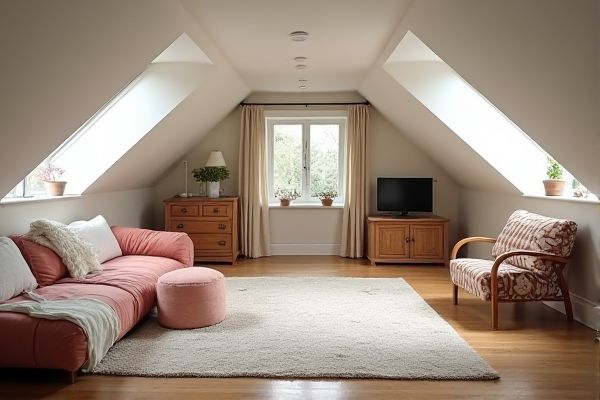
An attic playroom offers a cozy, secluded space with natural light and personalized decor, while a basement playroom provides ample room for large activities and is typically cooler with sound insulation benefits. Discover which option best suits Your family's needs and lifestyle by reading the full comparison ahead.
Table of Comparison
| Feature | Attic Playroom | Basement Playroom |
|---|---|---|
| Natural Light | High, with skylights or windows | Limited, usually requires artificial lighting |
| Temperature | Can be warmer in summer, cooler in winter without insulation | Generally cooler and stable year-round |
| Ventilation | Better airflow with windows and vents | Often more humid, requires dehumidifiers or ventilation systems |
| Space Availability | Usually smaller, limited by roof shape | Typically larger and more open |
| Noise Isolation | Less sound insulation from rest of house | Better sound isolation, quieter for adults |
| Safety | Requires safe stair access and guardrails | Easier to access, but may have dampness or mold risks |
| Costs | May require insulation and structural reinforcement | Often needs moisture control and finishing |
Introduction: Attic vs Basement Playrooms
Attic playrooms offer natural light, cozy insulation, and a quieter space ideal for focused activities, while basement playrooms provide spacious layouts and consistent temperatures, perfect for active play and storage. Your choice depends on factors like ceiling height, moisture control, and accessibility. Maximize your child's play experience by tailoring the space to your home's structural advantages and needs.
Space Utilization and Layout Considerations
Attic playrooms often capitalize on natural light from skylights and unique architectural features, creating cozy, well-lit spaces ideal for imaginative play, while basement playrooms provide larger, open areas with consistent temperature control, suitable for active games or media setups. Consider slope ceilings in attics which may limit vertical space but encourage creative furniture placement, whereas basements generally offer more uniform layouts but require moisture-proofing and adequate ventilation. Efficient use of space in attics involves built-in storage and nook utilization, contrasting with basements where zoning areas for different activities maximizes functionality.
Lighting: Natural vs Artificial
An attic playroom benefits from abundant natural lighting due to skylights or dormer windows, enhancing mood and reducing energy costs. Basement playrooms rely primarily on artificial lighting, requiring careful fixture placement and bright bulbs to create a lively atmosphere. Proper lighting design in either space ensures safety and a welcoming environment for children.
Temperature and Climate Control
Attic playrooms often face temperature fluctuations due to poor insulation and direct exposure to sunlight, making climate control a challenge that may require additional cooling and heating solutions. Basement playrooms tend to maintain a more consistent temperature year-round but can suffer from dampness and humidity, necessitating proper ventilation and dehumidification systems. You can ensure comfort in either space by investing in effective insulation, HVAC upgrades, and moisture control techniques tailored to the specific environment.
Safety Concerns in Attic and Basement Playrooms
Attic playrooms often pose safety concerns such as limited headroom, poor ventilation, and potential fire hazards due to wiring or insulation issues. Basement playrooms may face risks related to moisture, mold, and flooding, which can affect air quality and structural integrity. Ensuring Your attic or basement playroom has proper ventilation, fire safety measures, and moisture control is critical for a safe and healthy environment.
Accessibility and Convenience
An attic playroom often requires navigating steep stairs, making accessibility challenging for young children or individuals with mobility issues, whereas basements usually offer easier access with wider staircases or ground-level entrances. Basements tend to be closer to main living areas, providing greater convenience for supervision and quick entry during playtime. Attic spaces may offer privacy and separation from daily activities but at the cost of less immediate accessibility compared to basement playrooms.
Noise Control and Soundproofing
Attic playrooms often provide better noise control due to their elevated location, which naturally buffers sound from the main living areas below, making them ideal for quieter environments. Basement playrooms typically require more extensive soundproofing measures such as insulation, sound-absorbing panels, and sealed windows to prevent noise from echoing or disturbing upper floors. Effective soundproofing in both spaces enhances the play experience by minimizing noise disruption to the rest of the home.
Design and Decor Possibilities
Attic playrooms offer unique design possibilities with sloped ceilings and natural light from skylights, creating a cozy and whimsical atmosphere for your child's imagination. Basement playrooms provide a blank canvas with open layouts and controlled lighting, allowing for versatile themes and durable decor suited for active play. Your choice depends on whether you prefer the charming architectural features of an attic or the spacious, adaptable environment of a basement.
Cost Implications and Renovation Challenges
Attic playrooms often involve higher renovation costs due to structural modifications, insulation, and limited access, whereas basement playrooms typically require moisture control and potential waterproofing expenses. Attic conversions can encounter challenges like sloped ceilings and ventilation, impacting design flexibility, while basement playrooms may face issues with dampness and lower natural light. You should weigh these cost implications and renovation difficulties carefully to choose the best space for your family's play area.
Choosing the Right Playroom Space for Your Home
Choosing the right playroom space depends on factors like natural light, temperature control, and safety. Attic playrooms often offer bright, airy environments with good insulation, while basement playrooms provide cooler, quiet spaces with ample room and easy access to utilities. Assess your home's layout, ventilation, and noise levels to determine which area best supports your child's play activities and comfort.
 homyna.com
homyna.com